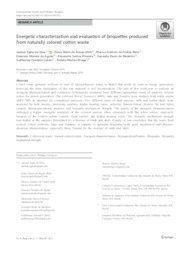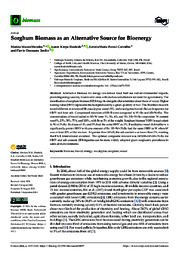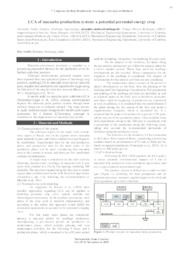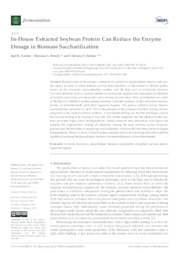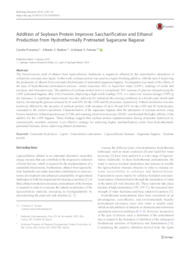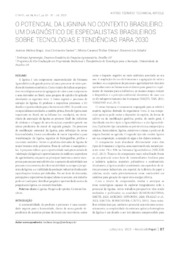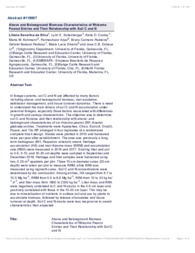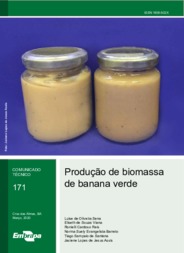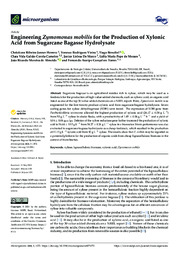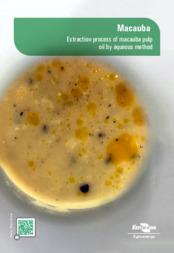Search Publications
Filter by:
| Author(s): SILVA, J. E. da; MELO, D. M. de A.; MELO, M. A. de F.; AGUIAR, E. M. de; PIMENTA, A. S.; MEDEIROS, E. P. de; CALIXTO, G. Q.; BRAGA, R. M. Cotton crops generate millions of tons of lignocellulosic waste in Brazil that could be used in energy generation; however, the main destination of this raw material is soil incorporation. The aim of... ... |
| Author(s): MORALES, M. M.; HOSHIDE, A. K.; CARVALHO, L. M. P.; TARDIN, F. D. lternative biomass for energy can reduce fossil fuel use and environmental impacts, providing energy security in semi-arid areas with shallow soils that are not ideal for agro-forestry. The densificat... ... |
| Author(s): CARDOSO, A. N.; RODRIGUES, T. O.; MARQUES, P.; FREIRE, F.; CASTANHEIRA, E.
|
| Author(s): SIMÕES, I. R.; BRONDI, M. G.; FARINAS, C. S. Bioconversion of the complex carbohydrates present in lignocellulosic biomass into simple sugars, in order to obtain biofuels and bio-based products, is still limited by the low performance of the enz... ... |
| Author(s): FLORENCIO, C.; BADINO, A. C.; FARINAS, C. S. The bioconversion yield of ethanol from lignocellulosic feedstocks is negatively affected by the unproductive adsorption of cellulolytic enzymes onto lignin. In this work, soybean protein was used as... ... |
| Author(s): BRAGA, M.; SANTOS, A. C. dos; DAMASO, M. C. T.; SCHULTZ, E. L. A lignina é um componente macromolecular da biomassa lignocelulósica de grande potencial como precursor de vários produtos de interesse econômico. Com o intuito de indicar as perspectivas tecnológicas... ... |
| Author(s): SILVA, L. S.; SOLLENBERGER, L. E.; COOLEY, K. D.; KOHMANN, M. M.; ARYAL, P.; PEDREIRA, B. C. e; PEDROSO, G. B.; SILVEIRA, M. L.; DUBEUX JÚNIOR, J. C. B. In forage systems, soil C and N are affected by many factors including above- and belowground biomass, root exudation, defoliation management, and tissue turnover dynamics. There is need to understand... ... |
| Author(s): SENA, L. de O.; VIANA, E. de S.; REIS, R. C.; BARRETO, N. S. E.; SANTANA, T. S. de; JESUS, J. L. de
|
| Engineering Zymomonas mobilis for the Production of Xylonic Acid from Sugarcane Bagasse Hydrolysate. Author(s): HERRERA, C. R. J.; VIEIRA, V. R.; BENOLIEL, T.; CARNEIRO, C. V. G. C.; MARCO, J. L. de; MORAES, L. M. P. de; ALMEIDA, J. R. M. de; TORRES, F. A. G. Sugarcane bagasse is an agricultural residue rich in xylose, which may be used as afeedstock for the production of high-value-added chemicals, such as xylonic acid, an organic acid listed as one of th... ... |
| |
Observation
Some of Embrapa's publications are published as ePub files. To read them, use or download one of the following free software options to your computer or mobile device. Android: Google Play Books; IOS: iBooks; Windows and Linux: Calibre.
Access other publications
Access the Agricultural Research Database (BDPA) to consult Embrapa's full library collection and records.
Visit Embrapa Bookstore to purchase books and other publications sold by Embrapa.

